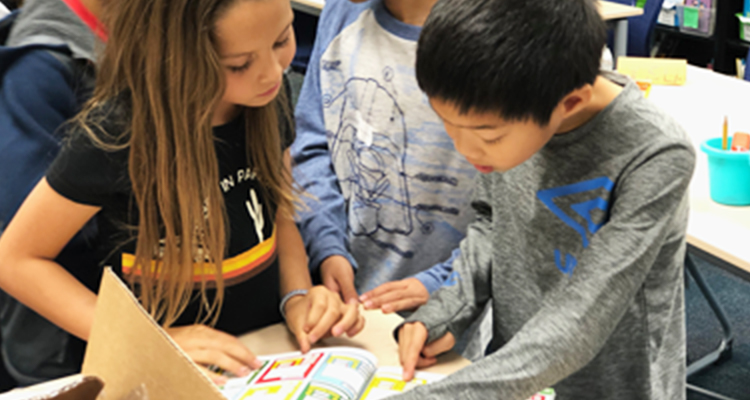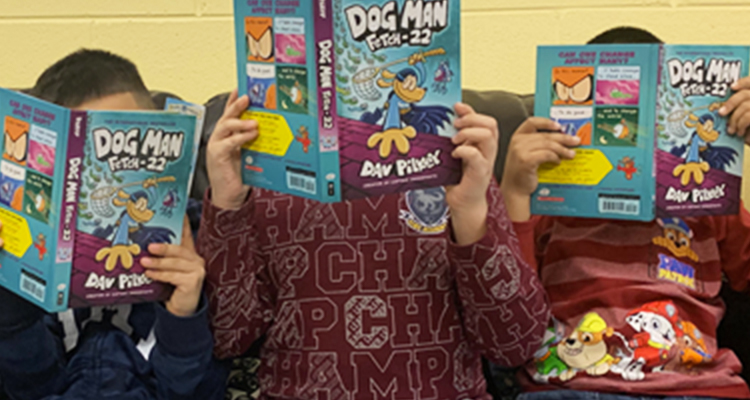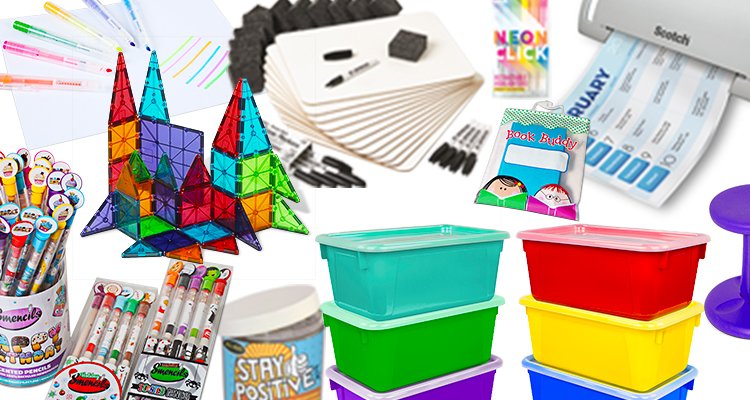100 Tips and Tricks
Helpful insider ideas on how to inspire your class to keep reading.


Tips and Tricks: How to Build Student Engagement
View All View LessLet Students Browse the Flyer
“Kids LOVE to browse through the flyers with their friends in class. It’s really fun to watch them talk to each other about what books they like. One kid almost fell off his chair when he saw the latest book in The Bad Guys series—He had to show EVERYONE!” —Scott B., 4th Grade Teacher, Camp Hill, Pennsylvania
Encourage students to make a wish list.
“Have the kids create a wish list! Give kids five minutes of class time to look through the flyers and make a list of the ones they like.” —Andrea C., 4th Grade Teacher, St. Louis, Missouri
Put literacy on FULL blast!
“I post a lot of student work on our classroom door and in the hallway, including what our class is currently reading and any fun student work they did. The rest of the school knows that my students are readers, and my students feel super proud of themselves!” —Nadya A., 2nd Grade Teacher, Falls Church, Virginia
Recommend books.
“I attach a ‘Mrs. Shafer Recommends’ letter to the flyers each month. (Thanks to Pinterest for the idea!) I tend to highlight three to four books—new books that I know kids will love, books connected to what we’re learning, or just my personal favorites.” —Niki S., 5th Grade Teacher, Freedom, Wisconsin
Let families know how easy it is to order online.
“Try emailing the link to the digital flyers instead of sending home the paper flyers! I did it for the first time this year and my families are LOVING the easy online access!” —Teresa B., PreK, Stillwater, Oklahoma
Personalize everything. (Or just this one thing!)
“Many first grade families want to know how to choose books ‘at their kids’ level,’ so when I send the flyers home, I attach a letter from me and include a few recommendations for books. For a handful of kids, I personalize the letter a bit more and add books that match their level best.” —Helen M., 1st Grade Teacher, Rowland Park, California
Send reminders.
“First, send a brief note with the flyers (write your own letter, google other teachers’ examples, or simply print the one in the catalog). Then, send lots of reminders—emails, texts, notes, phone calls. Reminders are key!” —Kerry-Ann R., 4th Grade Teacher, New Rochelle, New York
Show students all the FREE Books they earned for the classroom.
“Make sure you let your kids know how many FREE Books the classroom has earned and which ones they are! My kids know that when they place an order for books, they are also helping to expand our classroom library!” —Kyndel E., 5th Grade Teacher, Mobile, Alabama
Show off new books!
“I always keep the new books we’ve ordered from Book Clubs in a special basket in the classroom. Students can browse through the basket when they first arrive each morning. The leader of the day gets to choose one of the books and I’ll either do a read-aloud or simply preview the book with the class. The cutest is when the student does a preview of the book in front of the class!” —Sarah M., 1st Grade Teacher, Rumford, Maine
Make Book Box Day a reading celebration!
“When the Book Box arrives, I make a BIG deal about it and share all of the books I got for the class with the kids. They get so excited!” —Laura H., Kindergarten, Allendale, New Jersey


Tips and Tricks: How to Teach with Graphic Novels
View All View LessWHY: Benefits of Teaching with Graphic Novels
“Graphic novels are definitely a favorite go-to read in my class—I honestly cannot keep them on the shelves for long. For some kids, these books mean everything to them—they boost kids’ confidence, they encourage friendly conversations about books, and they transform a student who says, ‘I don’t read,’ to one who says, ‘When is the next Dog Man coming out?!’ —Jana P., 2nd Grade Teacher, Albany, Oregon
WHY: Benefits of Teaching with Graphic Novels
“I often will use books with graphic-novel elements to teach things such as: dialogue, voice, author’s purpose, etc. In first grade, we also talk about different types of books, so I use the Acorn series as my example of a graphic novel.” —Kelsey A., 1st Grade Teacher, Kent, Washington
WHY: Benefits of Teaching with Graphic Novels
“They are not only great for struggling readers, but also great to help students visualize more difficult stories and topics, as well as connect art with stories.” —Morganne M., 6th Grade Teacher, Stillwater, Oklahoma
Create an Anchor Chart
“Be sure to teach the characteristics of graphic novels and create an easily accessible anchor chart. Examples to teach: Gutters and why they are important, panels and how they move from scene to scene, speech bubbles vs. thought bubbles. All of these terms must be defined.” —Christine L., 4th Grade Teacher, Houston, Texas
Make Inferences
“I use graphic novels heavily when teaching inferencing. I’ll post a pic of a non-text page and have the kids tell me what’s going on.” —Stephanie T., LEAP Teacher, Holland, Ohio
Partner Reading
“I also love the Acorn books because of the use of dialogue. They’re perfect for reading partnerships, as each reader can take on the voice of one of the characters and make it their own. My readers love reading with their reading partners, and these books have proved to be a great addition to our classroom!” —Sarah M., 1st Grade Teacher, Rumford, Maine
Share the Reading
“One way I’ve taught using graphic novels is as a shared reading. I did a brief shared reading with my class using one of the Baby-Sitters Club books and we talked about how important it is to use the pictures to help build ideas about the characters and to build inferences.” —Kelsey P., 4th Grade Teacher, Ridgewood, New Jersey
Make Sure Kids Are Doing the Reading
“Require students to internalize what they are reading because graphic novels can be surface-level books for some students who are avoiding a deeper issue.…The success of students’ reading this is high, but use the book as a tool to ensure understanding and growth.” —Cassie T., 5th Grade Teacher, New Braunfels, Texas
Building Bridges for ELL Students
“As my ELL students get older, they want to read longer books but aren’t necessarily ready for novels/chapter books. Graphic novels are a perfect match—they’re longer books, most have chapters, and there is a lot of visual support! When I listen to my ELLs read aloud, their confidence has skyrocketed, and that’s the most important thing to me.” —Nadya A., 2nd Grade Teacher, Falls Church, VA/span>
Add to Writing Workshop
“My students are very familiar (and love) the Elephant and Piggie books as well as others from Mo Willems. It also connects to our writing workshop unit on small moments (personal narrative)—we encourage students to use speech bubbles in their sketches as it encourages dialogue (the idea of showing not telling so the writer’s voice becomes more active and less passive).” —Helen M. 1st Grade Teacher, Rowland Park, California


Tips and Tricks: Teacher Favorites in the Bonus Catalog!
View All View LessKore Wobble Chair: Kids and Teens
Don’t have one yet? It’s time. Every kid wants to use it? Get a couple!
“As the classroom environment continually changes, teachers must adapt to the needs of our students. A move toward more flexible seating can be costly, but this is a great option to get started, especially because you can use your points!” —Jana P., 2nd Grade Teacher, Albany, Oregon
Scotch Thermal Laminator
100+ classroom uses. You’ll be amazed you ever got along without it!
“Have you debated buying one of these for years? Same. Now is the time to get it! A personal laminator was one of the best investments I made in my classroom. I laminate kids’ work, center activities, classroom signs…literally everything!” —Sarah M., 1st Grade Teacher, Rumford, Maine
Book Buddy Bags
Protect your books on the go!
“Get your book and go! This bag is super durable and allows kids to bring their books with them wherever they go! Just bought these for the kids’ summer reading books and they’re soooo excited!” —Amme D., Kindergarten Teacher, Fair Oaks Ranch, Texas
Stay Positive in a Jar
A must-have for the modern, mindful classroom!
“I love this jar! Both students and teachers tend to get a little antsy and stressed at the end of the school year, and these notes are perfect to set the tone for the day. My class loves the ‘question’ cards—we always have really interesting conversations.” —Ashley H., 6th Grade Teacher, Lakewood, Colorado
Scented Smencils
A great way to celebrate all your students’ accomplishments this year!
“These make great student rewards! My kids LOVE these scented pencils so much that I’ve probably ordered three sets so far this year.” —Kyndel E., 5th Grade Teacher, Mobile, Alabama
Dry-Erase Board Class Set
For student use in class and at home!
“I love these! The whole kit is cost-effective—comes with 12 boards, markers, and mini erasers. In addition to using them in the classroom, I also give them to my families to work with their students at home.” —Audra D., PreK Teacher, Phoenix, Arizona
Magna Tiles
A fun toy that encourages creativity!
“Such a wonderful toy that affords so many creative opportunities! Kids will just build randomly, some will have an idea in mind, some will use specific patterns of size and color. Kids can use them in small groups, which helps the teacher encourage lots of communication and cooperation with the materials. We could never afford these without the Bonus Catalog. It’s definitely one of those products that children learn so much from without realizing it—it’s just fun for them!” —Terry C., Early Childhood Director, White Plains, New York
4-Tier Mobility Cart
A multi-use cart with wheels? Yes please!
“I’ve actually used these as another place to store books for my classroom library. In our classroom, we call it the ‘new’ cart as I put new book purchases on it when I don’t have time to catalog them for my classroom library just yet. Great for chapter books.” —Katie R., 4th/5th Grade Split, Elburn, Illinois
Neon Retractable Scented Highlighters
A simple tool to engage students!
“I use highlighters and blacklight flashlights to teach close reading, and the scents make it all the more fun! Students highlight the important elements in a different color, and then these stand out when we turn off the lights and have a blacklight party to see our thinking!” —Courtney S., 3rd Grade Teacher, Northbrook, IL
QuietSharp Classroom Electric Pencil Sharpener
Game-changing!
“This pencil sharpener is a game-changer. Unlike other pencil sharpeners, this one really delivers on their promise about being quiet. Kids can be more independent with this in the classroom which is key for kids in Upper Elementary.” —Scott B., 4th Grade Teacher, Camp Hill, Pennsylvania




